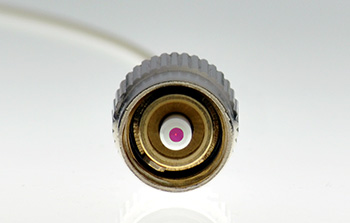Coatings for optical fibre tips have long played a role in optimising the performance of fibre optic systems, offering a range of functionality benefits.
Traditionally, these have been limited to anti-reflective coatings which minimise back reflection in applications such as optical communications and remote sensing. But one company has taken this a step further, with a novel technological approach to coating fibre tips with wavelength sensitivity designed to enhance speed, information fidelity and security in emerging applications such as quantum computing, fusion plasma monitoring, and minimally invasive surgery.
Sheetal Kumar Chanda, Director Of Engineering at Omega Optical explains: “Conventional Coatings on fibre tips are already widely available in the market. What is unique about Omega’s offering is Spectrally Complex Coatings on top of fibre tips. This means that we can put a high layer count coating that has traditionally been available only on a glass substrate, is now available on onto a fibre tip. This could be a broadband antireflection coating; reflector; one of our shortpass, longpass or bandpass filters; or any other custom filter profile that a customer might want.”

Omega can coat the tips of fibre optics with spectrally-complex coatings, including broadband antireflection coatings, reflectors and a full-range of filters (Bandpass pictured, credit: Omega Optical)
This novel technique started its life as part of an internal R&D project at Omega Optical, looking at the multispectral imaging of cancer cells by mapping wavelengths into the time domain. As part of this innovation, the team applied different longpass coatings on fibre tips to achieve the desired optical performance, and since then, they have never looked back. The company secured a contract with instrumentation manufacturer Nikira Labs and the National Institutes of Health (NIH) to use the process in the production of a fibre-optic bundle that is simultaneously used for laser Raman excitation and detection in a variety of applications, including in-vivo medical procedures.
Spectrally coated fibre tips for instrument miniaturisation
This technology has already found homes in applications such as fibre-based single photon detection, semiconductor metrology, and in Raman spectroscopy, as with the Nikira Labs project. One proven benefit the technique has lent to this particular application is the ability to achieve the all-important miniaturisation for instruments that had previously been deemed too complex or to require too many individual components from multiple sources. Says Chanda: “Miniaturisation is definitely a problem that this technology can solve if the optical designer considers it during the system design phase.”
Omega’s ability to structure a filter set on the end of a piece of fibre smaller than a single hair offers greater efficiency and flexibility for OEMs, so the application potential is almost limitless. Domenic Bucci, Business Development Manager, Life Sciences at Omega says: “Swapping out a fibre is infinitely much quicker and more efficient than a filter. Normally, these filters are buried very close into a light source, for instance, if you're doing any kind of sensitive light monitoring. Having that filter at the distal end of that fibre connection makes things so much quicker for the customer, and the speed of response and the service is much better. It means they can try things to experiment and it offers a tremendous amount of flexibility if they are trying to source out a variety of pieces of information.”
The ability to swap out the fibre brings additional benefits to applications in harsh environments, such as high energy detection, where other components and consumables may struggle to survive. Bucci explains: “The cameras used here can be up to $200,000, and if they become damaged, they get thrown out. A small fibre tip, however, could be replaced in terms of being able to have remote sensing with less casualty of product.” Adds Chanda: “These are all hard coated filters, so durability is not a concern. We can do several connect-disconnects without impacting the coating.”
Spectrally coated fibre tips for quantum applications
One emerging application to which spectrally coated fibre tips have shown real promise is quantum-based detection, communication, and computation. Says Bucci: “When you have quantum speeds being developed in quantum technology, everything matters, as you colour and stack, as you implement fibre versus copper versus free space, all of these things go to help improve the speed and the accuracy of the information and data being shared. There are a host of companies looking at quantum, and speed is very important. Information fidelity is very important. Plus, with fibre, there is a lot more security.”
One might be forgiven for thinking that applying such a coating technique to so many varied applications is no mean feat. “Fortunately,” says Bucci, “ At Omega, we have the high-quality technical staff available to help with all of these applications. We are the technology and the coating experts and we work closely with the application experts.”
Adds Justin Turner, Chief Marketing Officer at Omega Optical: “Combining the filters with the coatings on the fibre tips is a novel approach. The broad application set combined with a novel method provides a new way to expand our customers’ application space by enabling benefits such as miniaturisation. We can handle all fibres directly from all manufacturers, coat them and supply them to the OEM integrator.”
Further information
Find out more about Omega Optical at www.omega-optical.com


